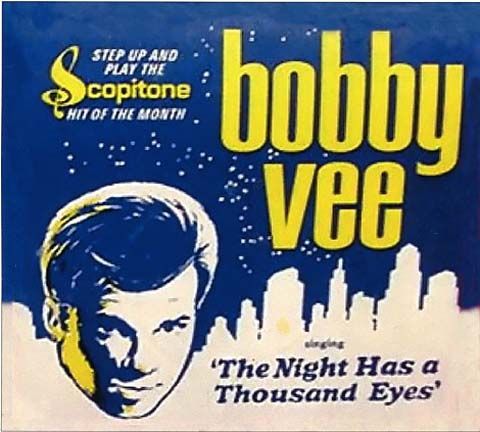|
Scopitone
films are the 1960s ancestors of today's music videos. They were
distributed on color 16mm film with a magnetic soundtrack, and were
made to be shown on a Scopitone film jukebox. The first Scopitones were
made in France in 1960, and the Scopitone craze spread throughout
Europe (particularly in West Germany and England) before crossing the
Atlantic to the United States in mid-1964. By the end of the 1960s,
they were gone.
In
its August 21, 1964 issue, Time magazine wrote: "...in some 500 bars,
restaurants, and servicemen's clubs throughout the US, the center of
attention these days is a monstrous new machine called Scopitone.
It
is a cross between a jukebox and TV. For 25 cents a throw, Scopitone
projects any one of 36 musical movies on a 26 inch screen, flooding the
premises with delicious color and hi-fi scooby-ooby-doo for three whole
minutes. It makes a sobering combination."
At
this point, optimism reigned supreme in the world of Scopitone. The New
York Times in 1965 reported of plans to manufacture about 5000
machines, 10000 in 1966 and similar amounts for future years to come.
But by 1967, reports of bad management and mob involvement in the
industry led to grand jury investigations; it soon became evident that
Scopitone was losing money hand over fist.
By
1969, Scopitone had closed its doors for good. What had seemed like a
sure thing only five years before, faded away in a sea of accusations
and murky accounting practices. The fickle American public didn't even
seem to care.
So
what was the appeal of the Scopitone videos? In 1964, with the big
introduction to the clubs and restaurants, new American films needed to
come faster than ever. The previous dependence on French videos and
story telling simply could not last to maintain interest here.
Harmon-ee
Productions, a subsidiary of a company owned by Debbie Reynolds, became
the main supplier of American films. Debbie herself starred in the
first American Scopitone video, singing "If I Had a Hammer," the Trini
Lopez hit. Later, she covered Gale Garnett's "We'll Sing in the
Sunshine."
In
keeping with the strategy of keeping teenagers out of the mix, the
artists viewed on the Scopitone tended toward the lounge acts of the
day- Vic Damone, Julie London- only occasionally a Bobby Vee or Petula
Clark might surface. But in spite of the seemingly static nature of
these artists, the resulting videos were visually stunning, if not
mystifying with their direction.
If
anything set the Scopitone films apart from anything else, it was their
use of eye-popping colors, wild scenery and wilder enthusiastic girls
dancing the Twist, usually in bikinis, in the backgrounds as the
singers performed in the craziest of places- on trains, in the woods,
in cars, on carnival rides.
In
many cases, what was filmed didn't seem to make sense in the context of
the song- for example, Dion singing "Ruby Baby" while seated in the
cockpit of an obviously stationary airplane on a runway or Dionne
Warwick singing "Walk on By" while lying seductively on a white bear
rug.
Some
of these films have been described as risque, even by our standards
today, not surprising, considering their French lineage and their
appeal to cocktail lounges and clubs where "sophisticated" gentlemen
could be found. In an age when Playboy magazine was redefining the
American male, is it any wonder then that certain Scopitones would
gravitate towards a more permissive point of view?
Jack
Stevenson, who wrote a definitive article on Scopitones, stated,
"...people were reduced to decoration. They were lip-synchers, gyrating
dolls and puppets and mannequins." It was a hypnotic effect and for
those three minutes, it was riveting.
The
Scopitone may have gone the way of the dinosaur but many remain safely
in collectors' hands. And you can still find one out there, though you
may have to travel a bit to find it. The Belcourt Theatre in Nashville,
Tennessee has what they've termed "the last public Scopitone in
America" in its lobby.
It
has embraced the Scopitone so much that it recently held a
Scopitone-themed membership drive, complete with "fashion contests,
nonstop Scopitones and '60s-themed food and drink." Just the thing if
you're in a groovy, kitschy mood. And
while it's not the same as seeing it on the real thing, many Scopitone
films are available online and on DVD collections. Just try a Google
search on the word.
|

